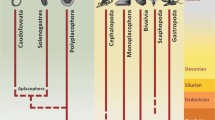Abstract
The effects on synaptic transmission of blockers of amino acids at postsynaptic receptors were investigated by means of external perfusion of the basal membrane of electroreceptor cells in ampullae of Lorenzini and by recording of spike activity from individual nerve fibers in the skateRaja clavata: glutamic acid diethyl ester (DEE-GLU), glutamic acid dimethyl ester (DME-GLU), D-α-aminoadipic acid (DAA), kynurenic acid (KYN), and cis-2,3-piperidine dicarboxylic acid (PDA). The most effective blocker was found to be DEE-GLU, producing reversible blockade of postsynaptic amino acid response. It was found that DAA did not change synaptic transmission in the electroreceptors, while PDA largely affected response produced by applying L-aspartic acid (L-ASP); KYN affected response produced by L-glutamic acid (L-GLU). It is deduced that L-GLU and L-ASP are the most effective agonists at the afferent synapse of ampullae of Lorenzini and that their excitatory effect is produced by activating quisqualate receptors.
Similar content being viewed by others
Literature Cited
G. N. Akoev, Yu. N. Andrianov, and N. O. Vol'ne, “Mechanisms of synaptic transmission in the skate ampullae of Lorenzini,” Neirofiziologiya,13, No. 3, 292–298 (1981).
G. N. Akoev, Yu. N. Andrianov, and N. O. Sherman, “Effects of glutamic and aspartic acids on electrical activity in the skate ampullae of Lorenzini,” Fiziol. Zh. SSSR,70, No. 3, 322–325 (1984).
G. N. Akeov, Yu. N. Andrianov, and N. O. Sherman, “Effects of kainic acid on synaptic transmission in electroreceptors (ampullae of Lorenzini) inRaja clavata,” Neirofiziologiya,18, No. 2, 147–153 (1986).
G. N. Akoev, Yu. N. Andrianov, and N. O. Sherman, “Effects of aspartic amino acid in electroreceptors of the skate,” Neirofiziologiya,19, No. 1, 61–67 (1987).
J. P. Annoni, S. L. Cochran, and W. Precht, “Pharmacology of the vestibular hair cell afferent fiber synapse in the frog,” J. Neurosci.,8, No. 8, 2106–2116 (1984).
S. C. Bledsoe, Jr. and R. P. Bobbin, “Effects of D-α-aminoadipate on excitation of afferent fibers in the lateral line ofXenopus laevis,” Neurosci. Lett.,32, No. 3, 315–320 (1982).
R. P. Bobbin, S. C. Bledsoe, Jr., and G. L. Jenison, “Neurotransmitters of the cochlea and lateral line organs,” In: Hearing Sciences: Recent Advances, C. I. Berlin, editor, College Hill Press, San Diego (1984), pp. 159–180.
J. Davis and J. C. Watkins, “Effects of magnesium ions on the responses of spinal neurones to excitatory acids and acetylcholine,” Brain Res.,130, No. 2, 364–368 (1977).
R. H. Evans, A. A. Francis, and J. C. Watkins, “Selective antagonism by Mg2+ of amino acid-induced depolarization of spinal neurones,” Experientia,33, No. 7, 489–491 (1977).
J. Fex and M. R. Martin, “Lack of effect of D,L-α-aminoadipate, an excitatory amino acid antagonist, on cat auditory nerve responses to sound,” Neuropharmacology,19, No. 6, 809–811 (1980).
A. C. Foster and G. E. Fagg, “Acidic amino acid binding sites in mammalian neuronal membranes: their characteristics and relationship to synaptic receptors,” Brain Res. Rev.,7, No. 2, 103–164 (1984).
S. Haldeman and H. McLennan, “The antagonistic action of glutamic acid diethylesters toward amino acid-induced and synaptic excitation of central neurons,” Brain Res.,45, No. 2, 393–400 (1972).
G. L. Jenison and R. P. Bobbin, “Effects of quisqualate on guinea pig cochlear potentials,” Abstr. Association for Research in Otolaryngology, St. Petersburg Beach (1983), pp. 23–27.
G. L. Jenison, S. Winbery, and R. P. Bobbin, “Comparative actions of quisqualate and N-methyl-D-aspartate, excitatory amino acid agonists, on guinea-pig cochlear potentials,” Comp. Biochem. Physiol., Ser. C,84, No. 2, 385–389 (1986).
T. Nagai and S. Obara, “Afferent facilitation induced by iontophoretic application on acidic amino acids in the ampullary electroreceptors of Plotosus,” J. Neurophysiol.,53, No. 4, 853–867 (1985).
A. Pastuszko, D. F. Wilson, and M. Erecińska, “Effect of kainic acid in rat brain synaptosomes: the involvement of calcium,” J. Neurochem.,43, No. 3, 747–754 (1984).
M. N. Perkins and T. W. Stone, “An iontophoresis investigation of the actions of convulsant kynurenines and the interaction with the endogeneous excitant quinolinic acid,” Brain Res.,247, No. 2, 184–187 (1982).
P. Valli, G. Zucca, I. Prigioni, et al., “The effect of glutamate on the frog semicircular canal,” Brain Res.,330, No. 1, 1–9 (1985).
J. C. Watkins, “Excitatory amino acids,” In: Kainic Acid as a Tool in Neurobiology, E. G. McGeer, et al., editors, New York (1978), pp. 37–69.
J. C. Watkins and R. H. Evans, “Excitatory amino acid transmitters,” Ann. Rev. Pharmacol. Toxicol.,21, 165–204 (1981).
Additional information
I. P. Pavlov Institute of Physiology, Academy of Sciences of the USSR, Leningrad. Translated from Neirofiziologiya, Vol. 20, No. 4, July–August, 1988, pp. 457–463.
Rights and permissions
About this article
Cite this article
Akoev, G.N., Andrianov, Y.N. & Sherman, N.O. Effects of some agonists of excitatory amino acids on synaptic transmission in the skate electroreceptors (ampullae of Lorenzini). Neurophysiology 20, 330–335 (1988). https://doi.org/10.1007/BF02198440
Received:
Issue Date:
DOI: https://doi.org/10.1007/BF02198440




